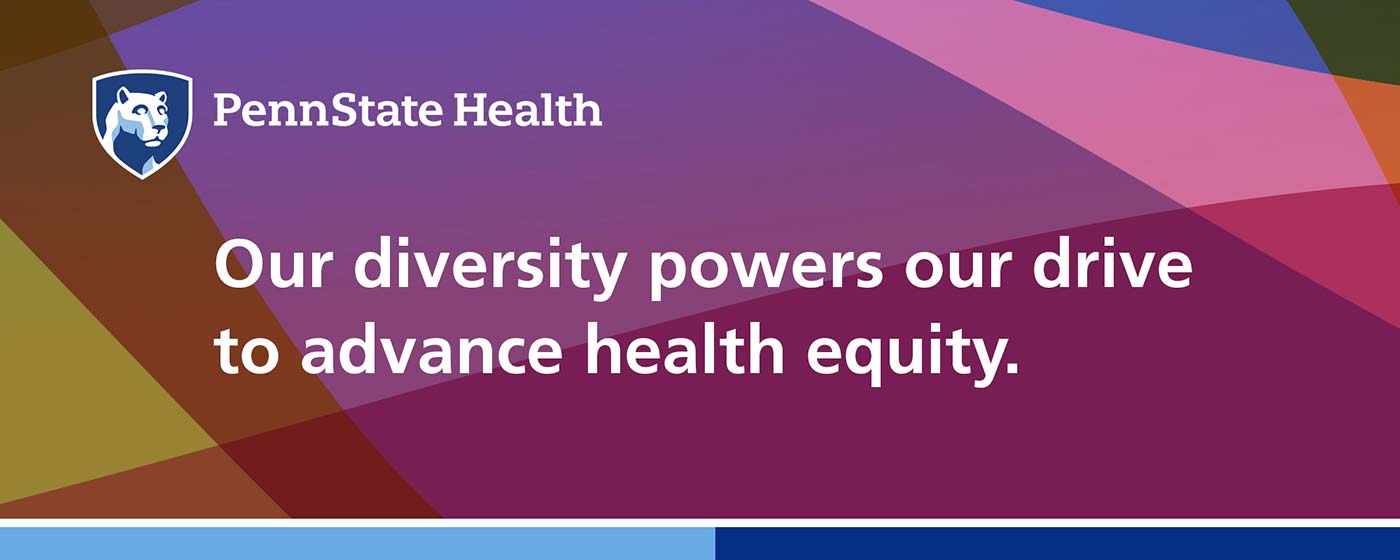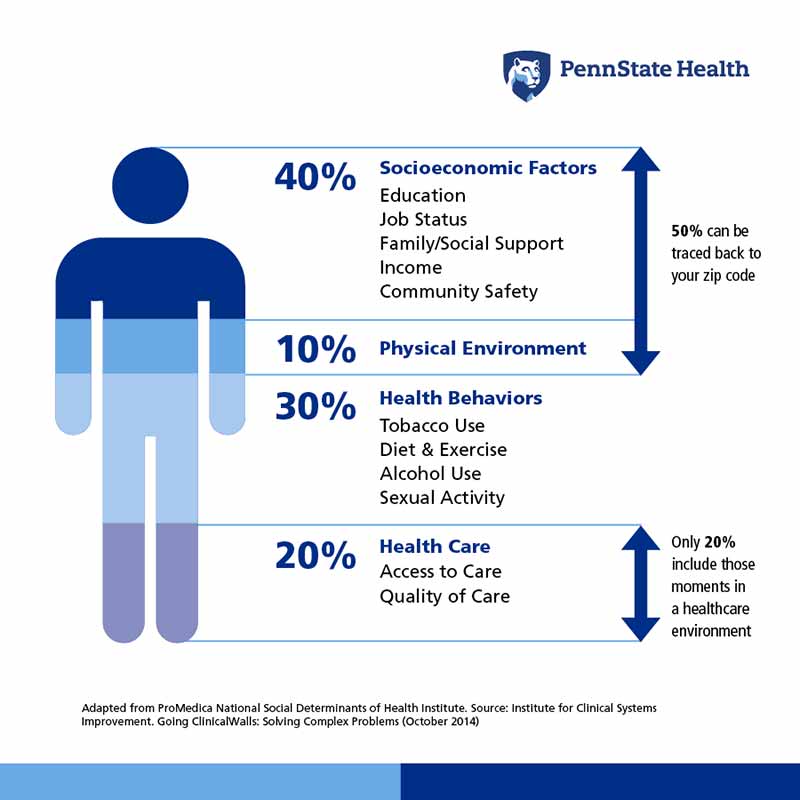
Penn State Health takes a systemwide approach to addressing health equity that is in line with the health system’s mission to continually improve the health and well-being of the people of Pennsylvania, and beyond. The Health Equity Program’s objective is to reduce incidences of health disparities among specific population groups, most often reflected in length and quality of life, rates and severity of disease, presence of other adverse health conditions and access to medical treatment.
On this page, you will find:
- Information about why health equity is important
- The impact health equity can have on patients and the community
- Updates on Penn State Health’s commitment to provide the highest-quality care to all patients and to support the health of our communities
We recognize that health outcomes involve more than just good health care but also include access to employment and healthy food, a safe living environment and exposure to racism, to name a few. As a result, Penn State Health’s focus on health equity will include all the factors that can impact a person’s health.
Improving Health Outcomes Through Health Equity
According to the Centers for Disease Control and Prevention, health equity is achieved when people have the opportunity to reach their full health potential, and no one is disadvantaged from achieving this potential because of social position or other socially determined circumstances.
A successful health equity program can have a tremendous impact on patient outcomes, preventive care, health care management and the ability to provide culturally responsive care to an increasingly diverse patient population. The specific benefits include:
- Decreased hospital readmissions and mortality rates
- Increased treatment success and medication compliance
- Improved performance
- Greater workforce representation that reflects the needs of the community
- Better patient access
About the Health Equity Program at Penn State Health
The goals of the Health Equity Program are to:
- Address health disparities – the differences among specific population groups in achieving their full health potential. These disparities can be measured by differences in incidence, prevalence, mortality, burden of disease and other adverse health conditions.
- Advance health equity – the opportunity for every person to achieve their highest level of health regardless of social or demographic factors, such as race, gender, income, geographic region or primary language spoken.
Health Equity Program pillars
The Health Equity Program focuses on the following areas, or pillars:
- Community engagement. Develop partnerships and increase visibility in diverse communities to increase the understanding and support of the unique needs of all communities.
- Health equity research. Strengthen Penn State Health’s infrastructure to optimize and guide scholarly research and quality improvement related to health equity and to increase diversity in clinical trials.
- Data infrastructure. Use quantitative and qualitative patient data to develop, inform and measure health care improvement strategies.
- Culturally appropriate patient care. Deliver compassionate, quality and safe health care in both inpatient and outpatient settings to provide consistent, equitable health outcomes and patient experience across all patient populations.
- Governance, leadership and workforce diversification and workplace climate. Cultivate an increasingly diverse leadership team and workforce that is thriving in a respectful, inclusive work environment.
- Organizational accountability. Effectively use organizational health equity influencers to sustain diversity, equity, inclusion and health equity progress, and advance a commitment to business diversity.
Facets for each pillar:
- Information Technology and Required Data
- Regulatory Requirements: Community, Outpatient, Inpatient
- Communication: Workforce governance, External Community
- Education
- Funding, Resources and Strategic Planning
A team of individuals throughout the health system is advancing the Health Equity Program pillars, in addition to factors that support these areas.
Penn State Health’s Progress in Addressing Health Equity
In November of 2022, Penn State Health convened a team of individuals from throughout the health system to advance the system-wide health equity program. These individuals identified the six priority areas (pillars) to be addressed. The team also began developing a written plan as required by Joint Commission regulations. In addition, the health system began the completion of the American Hospital Association’s Health Equity Roadmap.
In February of 2023, the health system’s boards were advised of the health system’s foundation for implementing its health equity program. Pursuant to CMS requirements, the boards will review the health equity program progress, as reflected in the written plan, and the health equity key performance indicators on an annual basis.
In April of 2023, the health system completed the American Hospital Association Health Equity Roadmap/Transformation Assessment for all five of its hospitals.
In July of 2023, the health equity team decided on focusing on health disparities related to stroke. The health system approved a new role, a program director for health equity, to lead the health system health equity program with support from the vice president and chief diversity officer and the vice president for value based care and population health.
Health Disparities Research
- The Importance of Social Determinants of Health and the Stigma of African-American Bias – American Journal of Medical Quality
- College of Medicine fellow finds Black, Hispanic severe allergy patients are less likely to receive allergy shots – Penn State College of Medicine
- Alumna, Cancer Institute staff member advances health equity in central PA – Penn State College of Medicine
Resources
- Advancing Health Equity in Chronic Disease Prevention and Management – Centers for Disease Control and Prevention
- Health Equity – World Health Organization
- Health Equity in Healthy People 2030 – Healthy People 2030
Contact Us
If you have questions about our Health Equity Program or would like more information, contact the Penn State Health Office for Diversity, Equity and Inclusion at [email protected].





